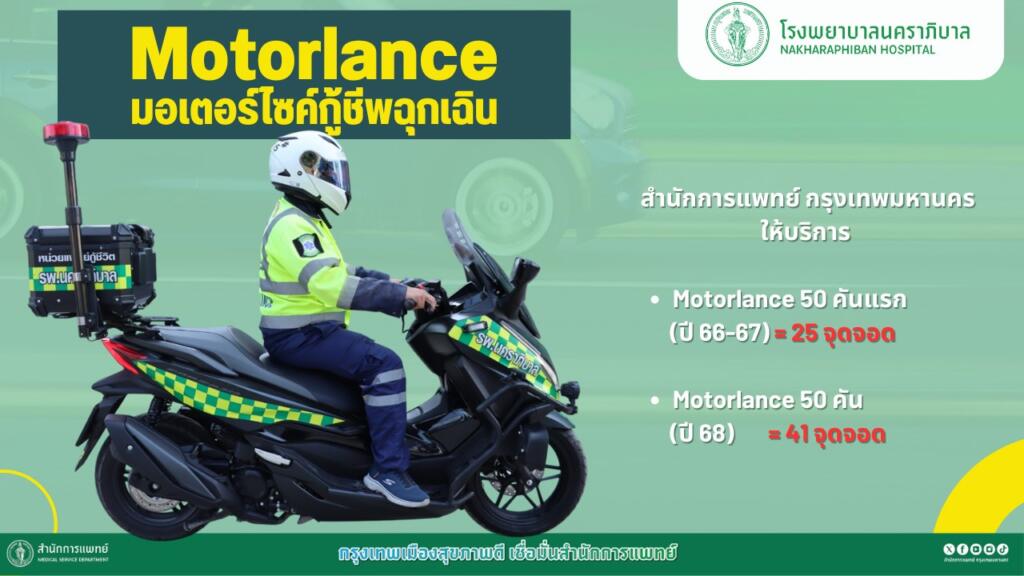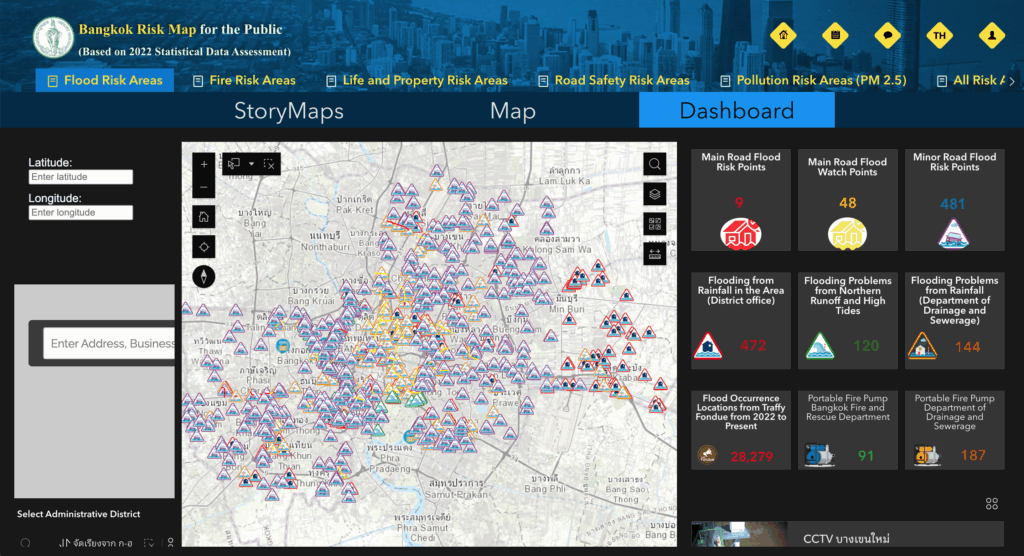Bangkok faces a perfect storm of urban challenges that threaten public health and strain emergency services. As one of the world’s rapidly developing megacities with over 10 million residents, the Thai capital grapples with extreme heat, frequent flooding, and notorious traffic congestion that can mean the difference between life and death in medical emergencies.
The World Bank documented that Bangkok’s Urban Heat Island effect elevates the city’s temperatures by up to 2.5°C above rural surroundings, creating conditions that exacerbate heat-related illnesses and strain public health systems. This extreme heat particularly affects the city’s substantial outdoor workforce, including motorbike drivers, leading to heat stress and significant productivity losses.
Beyond chronic heat exposure, Bangkok regularly experiences severe weather events that trigger widespread flash floods during monsoon season, disrupting urban mobility and blocking access to healthcare facilities. These climate impacts compound the city’s existing infrastructure weakness: severe traffic congestion that severely impedes traditional ambulance movement through the notoriously congested road network.
This creates a dangerous cycle where emergency medical services struggle with what experts call the “first-mile” challenge – reaching patients in dense, obstructed urban environments. The combination of narrow alleyways inaccessible to four-wheeled vehicles and submerged roads during flooding can render conventional ambulances completely inoperable, creating critical access gaps for patients in need.
The Solution: Motorlance Initiative
In response to these escalating challenges, the Bangkok Metropolitan Administration launched an innovative response: the motorcycle-based ambulance initiative, commonly known as “Motorlance.” This program, operated by the Erawan Unit under the BMA’s Medical Service Department, was designed not to replace traditional ambulances but to serve as rapid-response first-on-scene units capable of navigating Bangkok’s challenging urban terrain.

Research was conducted to inform the design of Motorlances, which consists of a specially equipped motorcycle outfitted with essential medical equipment, including an automated external defibrillator, portable oxygen cylinder, first aid kit, and trauma stabilization tools. The vehicle’s crew, typically a single highly-trained paramedic per vehicle, provides rapid on-scene assessment and advanced life support to stabilize patients until conventional ambulances arrive for transport.
This multi-stakeholder model involves direct collaboration between the BMA’s Erawan Unit, various public and private hospitals including Bangkok Hospital, and local community health workers. The Erawan Unit serves as the central coordination hub, strategically dispatching the most suitable vehicle—Motorlance or traditional ambulance—based on the reported emergency and current traffic conditions, creating a tiered response system that prioritizes speed and immediate stabilization.
Results
Studies conducted reveal remarkable improvements in emergency response metrics – motorcycle-based teams achieved a significantly faster mean response time of 7.20 minutes compared to 9.25 minutes for conventional ambulances, representing a crucial 22% improvement. Even more impressively, the activation time for these mobile units was just 0.44 minutes, substantially quicker than the 1.42 minutes required for conventional vehicles.
This speed advantage translates directly into saved lives, particularly for time-sensitive emergencies like cardiac arrest. The strategic placement of AEDs on these vehicles addresses the critical problem of delayed defibrillation in public areas lacking readily available emergency equipment.
Building Climate Resilience
Researchers have further highlighted that the Motorlance model builds systemic climate resilience beyond daily efficiency gains. The enhanced mobility and maneuverability of motorcycles allow paramedics to reach patients in areas where submerged roads would halt traditional ambulances during flooding events. This agility contributes to a more resilient healthcare system, ensuring continuity of care even when urban infrastructure is compromised by climate-related events.
By reaching patients faster, the initiative also reduces health system strain by preventing the escalation of medical emergencies that would otherwise require more intensive hospital resources. This approach fundamentally transforms emergency medical services from a single, large transport vehicle concept into a dynamic, multi-modal system that can withstand mobility disruptions caused by various urban stressors.
At the same time, the city operates a sophisticated real-time flood monitoring and early warning system, backed by over seventy hydrological sensor stations and integrated rainfall/runoff modeling (e.g., the RTFlood pilot at Ramkhamhaeng), to spatially forecast flood risks and notify affected communities via digital platforms—bolstering public preparedness during emergencies. This proactive warning system complements rapid response tactics by reducing surprise and facilitating coordinated action before flooding escalates.

Dashboard of flooding and at-risk areas in Bangkok, Source: Bangkok Risk Map
Conclusion
Bangkok’s Motorlance initiative represents a pragmatic and effective urban emergency response approach that demonstrates how cities can adapt emergency services to be more agile and responsive. The program’s success stems from its targeted focus on solving specific urban vulnerabilities while building broader systemic resilience against both daily urban pressures and the increasing frequency and intensity of climate-induced health risks.
As the World Health Organization emphasizes in their framework for strengthening health systems, integrating emergency services into broader urban resilience planning is crucial for megacities worldwide. Bangkok’s approach offers a replicable model for densely populated cities seeking to bolster their emergency medical services while confronting similar combinations of climate stress, population density, and infrastructure constraints.
The initiative’s demonstrated ability to reduce response times while improving clinical outcomes makes it a valuable blueprint for urban emergency response innovation, proving that strategic adaptation can transform healthcare system capabilities in the face of mounting urban and climate challenges.
Krape Sadakorn, Researcher
References:
- Bangkok Metropolitan Administration. (n.d.). Erawan Unit. Medical Service Department. Retrieved August 27, 2025, http://www.msdbangkok.go.th/HOMEENG.html
- Chaiklieng, S., & Panyapinitnukul, J. (2022). Health status of patients and services provided by motor-driven emergency vehicles, Bangkok. Archives of Public Health, 80(1), 126. doi:10.1186/s13690-022-00833-2. https://archivesofpublichealth.biomedcentral.com/articles/10.1186/s13690-022-00833-2
- Over 70 real-time rainfall/water level sensors integrated in Bangkok’s monitoring network
Challenges for adapting Bangkok’s flood management systems to climate change – ScienceDirect - Real-time flood forecasting system (RTFlood) case study in Ramkhamhaeng polder https://doi.org/10.3390/w14101641
- Intraprasert, S., Vatcharaprasert, R., & Khongsawad, S. (2022). A comparison of the response time of motorcycle-based advanced life support units and conventional ambulances in a university hospital. Open Access Emergency Medicine, 14, 463-469. doi:10.2147/OAEM.S361335 https://www.ncbi.nlm.nih.gov/pmc/articles/PMC9013265/
- World Bank. (2019). Shaping a Cooler Bangkok: Tackling Urban Heat for a More Livable City.https://www.worldbank.org/en/country/thailand/publication/shaping-a-cooler-bangkok-tackling-urban-heat-for-a-more-livable-city
- World Health Organization. (2020). Emergency and essential surgical care and anaesthesia: A framework for strengthening health systems. WHO Press. https://www.who.int/publications/i/item/emergency-and-essential-surgical-care-and-anaesthesia-a-framework-for-strengthening-health-systems



